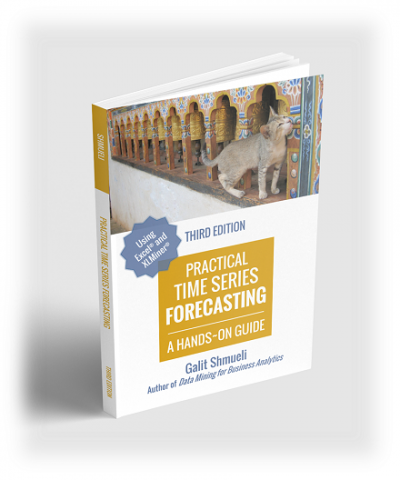Foreword by Gareth James xix
Foreword by Ravi Bapna xxi
Preface to the R Edition xxiii
Acknowledgments xxvii
PART I PRELIMINARIES
CHAPTER 1 Introduction 3
1.1 What Is Business Analytics? 3
1.2 What Is Data Mining? 5
1.3 Data Mining and Related Terms 5
1.4 Big Data 6
1.5 Data Science 7
1.6 Why Are There So Many Different Methods? 8
1.7 Terminology and Notation 9
1.8 Road Maps to This Book 11
Order of Topics 11
CHAPTER 2 Overview of the Data Mining Process 15
2.1 Introduction 15
2.2 Core Ideas in Data Mining 16
2.3 The Steps in Data Mining 19
2.4 Preliminary Steps 21
2.5 Predictive Power and Overfitting 33
2.6 Building a Predictive Model 38
2.7 Using R for Data Mining on a Local Machine 43
2.8 Automating Data Mining Solutions 43
PART II DATA EXPLORATION AND DIMENSION REDUCTION
CHAPTER 3 Data Visualization 55
3.1 Uses of Data Visualization 55
3.2 Data Examples 57
3.3 Basic Charts: Bar Charts, Line Graphs, and Scatter Plots 59
3.4 Multidimensional Visualization 67
3.5 Specialized Visualizations 80
3.6 Summary: Major Visualizations and Operations, by Data Mining Goal 86
CHAPTER 4 Dimension Reduction 91
4.1 Introduction 91
4.2 Curse of Dimensionality 92
4.3 Practical Considerations 92
4.4 Data Summaries 94
4.5 Correlation Analysis 97
4.6 Reducing the Number of Categories in Categorical Variables 99
4.7 Converting a Categorical Variable to a Numerical Variable 99
4.8 Principal Components Analysis 101
4.9 Dimension Reduction Using Regression Models 111
4.10 Dimension Reduction Using Classification and Regression Trees 111
PART III PERFORMANCE EVALUATION
CHAPTER 5 Evaluating Predictive Performance 117
5.1 Introduction 117
5.2 Evaluating Predictive Performance 118
5.3 Judging Classifier Performance 122
5.4 Judging Ranking Performance 136
5.5 Oversampling 140
PART IV PREDICTION AND CLASSIFICATION METHODS
CHAPTER 6 Multiple Linear Regression 153
6.1 Introduction 153
6.2 Explanatory vs. Predictive Modeling 154
6.3 Estimating the Regression Equation and Prediction 156
6.4 Variable Selection in Linear Regression 161
CHAPTER 7 k-Nearest Neighbors (kNN) 173
7.1 The k-NN Classifier (Categorical Outcome) 173
7.2 k-NN for a Numerical Outcome 180
7.3 Advantages and Shortcomings of k-NN Algorithms 182
CHAPTER 8 The Naive Bayes Classifier 187
8.1 Introduction 187
8.2 Applying the Full (Exact) Bayesian Classifier 189
8.3 Advantages and Shortcomings of the Naive Bayes Classifier 199
CHAPTER 9 Classification and Regression Trees 205
9.1 Introduction 205
9.2 Classification Trees 207
9.3 Evaluating the Performance of a Classification Tree 215
9.4 Avoiding Overfitting 216
9.5 Classification Rules from Trees 226
9.6 Classification Trees for More Than Two Classes 227
9.7 Regression Trees 227
9.8 Improving Prediction: Random Forests and Boosted Trees 229
9.9 Advantages and Weaknesses of a Tree 232
CHAPTER 10 Logistic Regression 237
10.1 Introduction 237
10.2 The Logistic Regression Model 239
10.3 Example: Acceptance of Personal Loan 240
10.4 Evaluating Classification Performance 247
10.5 Example of Complete Analysis: Predicting Delayed Flights 250
10.6 Appendix: Logistic Regression for Profiling 259
Appendix A: Why Linear Regression Is Problematic for a Categorical Outcome 259
Appendix B: Evaluating Explanatory Power 261
Appendix C: Logistic Regression for More Than Two Classes 264
CHAPTER 11 Neural Nets 271
11.1 Introduction 271
11.2 Concept and Structure of a Neural Network 272
11.3 Fitting a Network to Data 273
11.4 Required User Input 285
11.5 Exploring the Relationship between Predictors and Outcome 287
11.6 Advantages and Weaknesses of Neural Networks 288
CHAPTER 12 Discriminant Analysis 293
12.1 Introduction 293
12.2 Distance of a Record from a Class 296
12.3 Fisher’s Linear Classification Functions 297
12.4 Classification Performance of Discriminant Analysis 300
12.5 Prior Probabilities 302
12.6 Unequal Misclassification Costs 302
12.7 Classifying More Than Two Classes 303
12.8 Advantages and Weaknesses 306
CHAPTER 13 Combining Methods: Ensembles and Uplift Modeling 311
13.1 Ensembles 311
13.2 Uplift (Persuasion) Modeling 317
13.3 Summary 324
PART V MINING RELATIONSHIPS AMONG RECORDS
CHAPTER 14 Association Rules and Collaborative Filtering 329
14.1 Association Rules 329
14.2 Collaborative Filtering 342
14.3 Summary 351
CHAPTER 15 Cluster Analysis 357
15.1 Introduction 357
15.2 Measuring Distance between Two Records 361
15.3 Measuring Distance between Two Clusters 366
15.4 Hierarchical (Agglomerative) Clustering 368
15.5 Non-Hierarchical Clustering: The k-Means Algorithm 376
PART VI FORECASTING TIME SERIES
CHAPTER 16 Handling Time Series 387
16.1 Introduction 387
16.2 Descriptive vs. Predictive Modeling 389
16.3 Popular Forecasting Methods in Business 389
16.4 Time Series Components 390
16.5 Data-Partitioning and Performance Evaluation 395
CHAPTER 17 Regression-Based Forecasting 401
17.1 A Model with Trend 401
17.2 A Model with Seasonality 407
17.3 A Model with Trend and Seasonality 411
17.4 Autocorrelation and ARIMA Models 412
CHAPTER 18 Smoothing Methods 433
18.1 Introduction 433
18.2 Moving Average 434
18.3 Simple Exponential Smoothing 439
18.4 Advanced Exponential Smoothing 442
PART VII DATA ANALYTICS
CHAPTER 19 Social Network Analytics 455
19.1 Introduction 455
19.2 Directed vs. Undirected Networks 457
19.3 Visualizing and Analyzing Networks 458
19.4 Social Data Metrics and Taxonomy 462
19.5 Using Network Metrics in Prediction and Classification 467
19.6 Collecting Social Network Data with R 471
19.7 Advantages and Disadvantages 474
CHAPTER 20 Text Mining 479
20.1 Introduction 479
20.2 The Tabular Representation of Text: Term-Document Matrix and “Bag-of-Words” 480
20.3 Bag-of-Words vs. Meaning Extraction at Document Level 481
20.4 Preprocessing the Text 482
20.5 Implementing Data Mining Methods 489
20.6 Example: Online Discussions on Autos and Electronics 490
20.7 Summary 494
PART VIII CASES
CHAPTER 21 Cases 499
21.1 Charles Book Club 499
21.2 German Credit 505
21.3 Tayko Software Cataloger 510
21.4 Political Persuasion 513
21.5 Taxi Cancellations 517
21.6 Segmenting Consumers of Bath Soap 518
21.7 Direct-Mail Fundraising 521
21.8 Catalog Cross-Selling 524
21.9 Predicting Bankruptcy 525
21.10 Time Series Case: Forecasting Public Transportation Demand 528
Index 535

